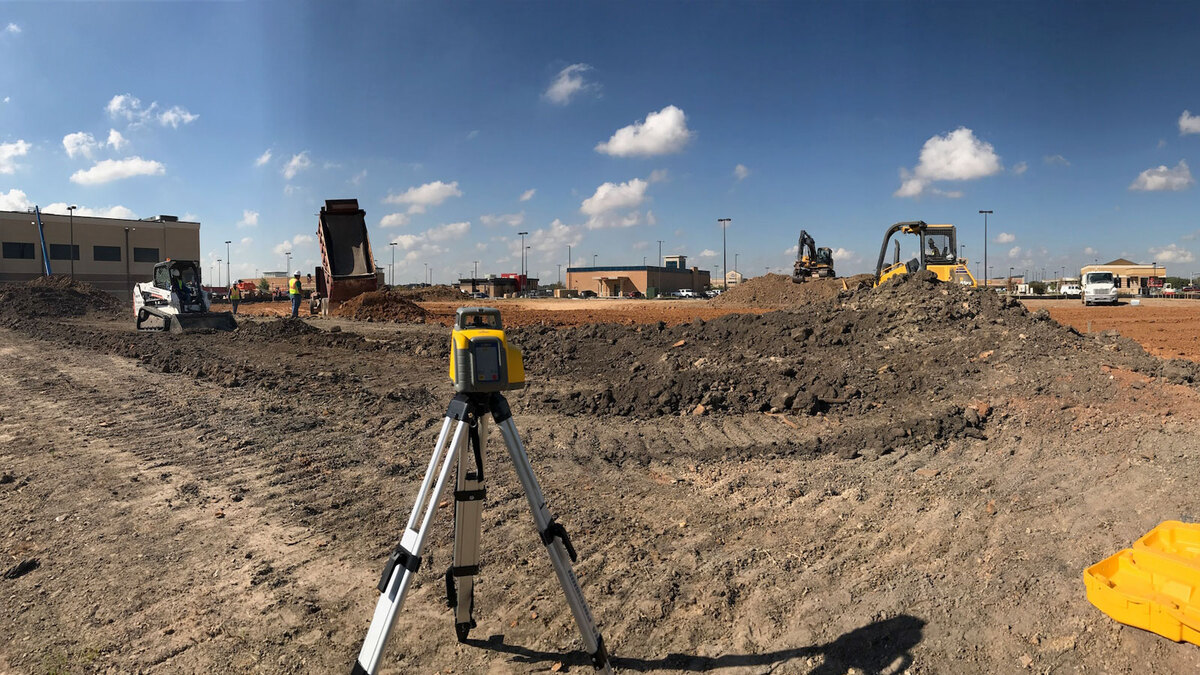Home>diy>Building & Construction>What Is The Critical Path In Construction


Building & Construction
What Is The Critical Path In Construction
Modified: December 7, 2023
Learn about the critical path in building construction and its importance in ensuring project efficiency and timely completion. Explore the key factors that influence the critical path and how to effectively manage it.
(Many of the links in this article redirect to a specific reviewed product. Your purchase of these products through affiliate links helps to generate commission for Storables.com, at no extra cost. Learn more)
Introduction
In the world of construction, there is a delicate balance between time, resources, and project deliverables. Completing a construction project on time and within budget requires careful planning and effective management. One crucial aspect of project management is understanding and optimizing the critical path.
The critical path is a concept that originated in project management theory and is widely used in the construction industry. It refers to the series of tasks that must be completed in a specific order and within a defined timeframe to ensure the successful completion of a project. This path determines the minimum duration required to complete the project and identifies the tasks that have the greatest impact on the project schedule.
Understanding and effectively managing the critical path is integral to project success. By identifying the critical path, project managers can prioritize tasks, allocate resources efficiently, and minimize delays and disruptions. In this article, we will explore the definition and importance of the critical path in construction, as well as discuss how to identify and manage it for optimal project outcomes.
Key Takeaways:
- Understanding and managing the critical path in construction projects is crucial for efficient resource allocation, risk mitigation, and timely project completion. It leads to improved project planning, enhanced resource utilization, and minimized project risks.
- Proactive critical path management is essential for overcoming challenges such as uncertainty, resource constraints, and complex task dependencies. Successful case studies highlight the importance of prioritizing critical tasks, optimizing resource allocation, and actively managing risks.
Read more: How To Make A Stepping Stone Path
Definition of Critical Path
In construction project management, the critical path refers to the sequence of activities or tasks that determine the longest duration required to complete the project. These tasks are interdependent, meaning that the completion of one task is necessary for the start or continuation of the next task in the sequence.
When we lay out all the tasks required for a construction project, we can identify the dependencies and relationships between them. By analyzing these dependencies, we can determine which tasks are on the critical path.
The critical path is characterized by two key factors: task duration and task interdependencies. Tasks on the critical path have zero slack or float, meaning that any delay in these tasks will impact the overall project schedule. These tasks directly affect the project’s completion date, and any delays in them will cause a delay in the entire project.
Identifying the critical path is crucial to project planning and resource allocation. It helps project managers prioritize tasks, allocate resources effectively, and make informed decisions to ensure the project stays on schedule.
The critical path is often represented as a network diagram or Gantt chart, where tasks are depicted as nodes or bars, and the relationships between them are represented by arrows or dependencies. This visual representation allows project managers to easily identify the critical tasks, understand their dependencies, and monitor their progress throughout the project.
It’s important to note that the critical path can change as the project progresses. As tasks are completed or delays occur, the critical path may shift, and project managers need to constantly monitor and update the project schedule to ensure the new critical path is accounted for.
Importance of Critical Path in Construction
The critical path plays a vital role in construction project management for several reasons. Understanding and effectively managing the critical path is crucial to ensuring project success and meeting client expectations. Here are some key reasons why the critical path is important in construction:
- Time Management: The critical path helps project managers identify the tasks that have the most significant impact on the project timeline. By focusing on these critical tasks, project managers can allocate resources and plan accordingly to ensure that the project stays on schedule. This helps avoid delays and costly schedule revisions, ultimately saving time and reducing project risks.
- Resource Allocation: The critical path allows project managers to allocate resources efficiently. By identifying tasks that are critical to the project’s completion, project managers can prioritize the allocation of labor, equipment, and materials to ensure that these tasks are given the necessary resources. This optimizes resource utilization, minimizes bottlenecks, and improves overall project productivity.
- Risk Management: The critical path helps project managers identify and mitigate potential risks and uncertainties. By focusing on critical tasks, project managers can anticipate any potential delays or problems that may arise and take proactive measures to address them. This enables them to manage risks effectively, minimize disruptions, and maintain project momentum.
- Client Communication: The critical path provides project managers with a clear framework to communicate project progress and timelines to clients. By highlighting the critical tasks and their dependencies, project managers can effectively communicate project milestones and expectations. This fosters transparency and helps manage client expectations, leading to improved client satisfaction and trust.
- Decision Making: The critical path serves as a basis for making informed decisions throughout the construction project. By understanding the tasks that have the greatest impact on the project schedule, project managers can make strategic decisions regarding project priorities, resource reallocation, and change management. This ensures that decisions align with project objectives and support the timely completion of the project.
In essence, the critical path provides construction project managers with the necessary insights and tools to effectively plan, monitor, and control the project. It helps streamline processes, optimize resource allocation, and minimize risks. By understanding and managing the critical path, project managers can enhance project efficiency, meet project deadlines, and deliver successful construction projects.
Identifying the Critical Path
Identifying the critical path in construction projects requires a thorough understanding of the project’s tasks, dependencies, and durations. There are several methods and techniques that project managers can use to determine the critical path. Here are the steps involved in identifying the critical path:
- Create a Work Breakdown Structure (WBS): The first step is to break down the project into smaller, manageable tasks. This is done by creating a Work Breakdown Structure (WBS), which organizes the project into hierarchical levels of tasks. Each task should have a clear start and end point.
- Determine Task Dependencies: Once the tasks are identified, project managers need to determine the dependencies between them. Dependencies can be of different types, including finish-to-start (FS), start-to-start (SS), finish-to-finish (FF), and start-to-finish (SF). This information is crucial in identifying the sequence in which tasks need to be completed.
- Estimate Task Durations: Project managers need to estimate the duration required to complete each task. This can be done by consulting subject matter experts, historical data, or utilizing industry standards. Accurately estimating task durations is vital for determining the critical path.
- Create the Network Diagram: Using the task dependencies and durations, project managers can create a network diagram. This diagram visually represents the sequence of tasks and their interdependencies. It helps project managers visualize the critical path and identify the tasks that have the greatest impact on the project’s duration.
- Calculate the Early Start (ES) and Early Finish (EF) Dates: Starting with the first task in the network diagram, project managers can calculate the Early Start (ES) and Early Finish (EF) dates for each task, taking into account task durations and dependencies. The Early Start date is the earliest possible start date for a task, while the Early Finish date is the earliest possible completion date.
- Calculate the Late Start (LS) and Late Finish (LF) Dates: After calculating the Early Start and Early Finish dates, project managers can calculate the Late Start (LS) and Late Finish (LF) dates. The Late Start date is the latest possible start date for a task without delaying the project’s completion, while the Late Finish date is the latest possible completion date without delaying the project’s completion.
- Identify the Critical Path: Finally, project managers can identify the critical path by analyzing the tasks with zero slack or float. These tasks have no flexibility in scheduling and directly impact the overall project duration. Tasks on the critical path must be closely monitored and managed to ensure the project stays on track.
By following these steps and using project management tools and software, project managers can accurately identify the critical path and gain a clear understanding of the tasks that require careful attention and resource allocation.
Elements Affecting Critical Path
Several elements can have an impact on the critical path in construction projects. These elements play a crucial role in determining the sequence and duration of tasks, and subsequently, the overall critical path. Understanding and managing these elements is essential for effective project planning and execution. Here are some key elements that can affect the critical path:
- Task Dependencies: The dependencies between tasks are a fundamental element that affects the critical path. If there are many dependencies between tasks, the critical path can become longer and more complex. On the other hand, if tasks can be executed in parallel or have more flexible dependencies, it may reduce the critical path duration.
- Task Durations: The duration of each task directly affects the critical path. Tasks with longer durations that are part of the critical path will have a more significant impact on the overall project schedule. Accurate estimation of task durations is crucial for understanding the critical path and managing project timelines effectively.
- Resource Availability: The availability and allocation of resources, such as labor, equipment, and materials, can impact the critical path. If resources are limited or not adequately allocated, it can cause delays in critical tasks, ultimately affecting the project schedule. Efficient resource management is crucial for maintaining the critical path.
- Risk Factors: Risks and uncertainties can have a significant impact on the critical path. Potential delays due to unforeseen circumstances, such as adverse weather conditions, supply chain disruptions, or regulatory issues, can disrupt the critical path and extend the project timeline. Identifying and mitigating risk factors is essential for minimizing their impact on the critical path.
- Change Management: Changes in project scope or requirements can affect the critical path. When changes occur, project managers need to assess the impact on the critical path and make necessary adjustments to maintain project timelines. Effective change management practices help prevent delays and ensure that the critical path remains on track.
- External Dependencies: Construction projects often rely on external factors, such as permits, approvals, or coordination with other stakeholders. Delays in obtaining necessary permits or dependencies on external parties can impact the critical path. Close collaboration, communication, and proactive management with external entities are essential for managing external dependencies and minimizing their impact on the critical path.
These elements are interconnected, and changes in one can cascade to others. Therefore, project managers need to carefully consider and evaluate these elements throughout the construction project lifecycle to effectively manage the critical path. By understanding how these elements affect the critical path, project managers can proactively address potential issues, allocate resources efficiently, and ensure timely project completion.
Read more: Garden Path Ideas: Brick Walkways
Managing the Critical Path
Managing the critical path is crucial to ensure the successful completion of construction projects within the specified timeline. Project managers employ various strategies and techniques to effectively manage the critical path and keep the project on track. Here are some key approaches to managing the critical path:
- Task Prioritization: Project managers need to prioritize tasks on the critical path to ensure that resources and efforts are focused on completing these tasks first. By identifying critical tasks and allocating resources accordingly, project managers can prevent delays and keep the project on schedule.
- Resource Optimization: Efficient resource allocation is essential for managing the critical path. Project managers need to ensure that the necessary resources, such as labor, equipment, and materials, are available when needed. Proper resource planning and scheduling can help avoid bottlenecks and delays in critical tasks, allowing the project to progress smoothly.
- Monitoring and Tracking: Regular monitoring and tracking of the critical path tasks are vital for effective management. Project managers need to keep a close eye on the progress of critical tasks, ensuring that they are on schedule and any deviations are promptly addressed. This may involve regular progress meetings, status updates, and using project management software to track task completion.
- Risk Management: Managing risks effectively is essential for mitigating any potential threats to the critical path. Project managers need to identify and analyze risks that can impact critical tasks and develop contingency plans to address them. By proactively managing risks, project managers can reduce the likelihood of delays and disruptions to the critical path.
- Communication and Collaboration: Effective communication and collaboration among project stakeholders are crucial for managing the critical path. Project managers need to maintain open lines of communication, ensuring that all team members are aligned with project objectives and deadlines. Regular communication helps identify and address any issues promptly, minimizing their impact on the critical path.
- Change Control: Changes are inevitable in construction projects, and they can have a significant impact on the critical path. Project managers need to implement a robust change control process to evaluate and manage the impact of changes on the critical path. Analyzing the potential effects of changes, making informed decisions, and adjusting the project plan accordingly can help prevent delays and keep the critical path intact.
By employing these strategies and techniques, project managers can proactively manage the critical path, minimize risks, and ensure the on-time completion of construction projects. Effective management of the critical path contributes to improved project efficiency, cost savings, and client satisfaction.
The critical path in construction is the sequence of tasks that determines the project’s duration. Identify it to prioritize resources and avoid delays.
Benefits of Optimizing the Critical Path
Optimizing the critical path in construction projects offers numerous benefits that contribute to the successful completion of projects. By focusing on the critical tasks that have the most impact on the project timeline, project managers can enhance project efficiency, resource utilization, and overall project outcomes. Here are some key benefits of optimizing the critical path:
- Improved Project Planning: Optimizing the critical path involves a detailed analysis of tasks, dependencies, and durations. This level of planning and analysis leads to better project understanding and a more accurate project plan. By identifying the critical tasks and their interdependencies, project managers can develop a more realistic and achievable project schedule.
- Enhanced Resource Allocation: Optimizing the critical path helps in efficient resource allocation and utilization. By focusing on critical tasks, project managers can prioritize resource allocation to ensure that the necessary labor, equipment, and materials are available when needed. This prevents resource bottlenecks and delays, leading to improved project productivity.
- Time and Cost Savings: By optimizing the critical path, project managers can minimize project duration and associated costs. By identifying and prioritizing critical tasks, they can allocate resources and manage risks effectively, reducing the likelihood of delays and costly schedule revisions. This results in time and cost savings for the project.
- Enhanced Project Control: Optimizing the critical path provides project managers with a clearer understanding of project progress and potential risks. By closely monitoring and managing the critical tasks, project managers can exercise better control over the project. They can identify any deviations from the planned schedule and take corrective actions promptly to ensure the project stays on track.
- Minimized Project Risks: Optimizing the critical path involves a thorough analysis of potential risks and their impact on the project timeline. By identifying and managing risks effectively, project managers can prevent delays and disruptions. Proactive risk management ensures that potential risks are addressed before they have a negative impact on the critical path.
- Improved Communication and Stakeholder Satisfaction: Optimizing the critical path enables project managers to communicate project progress and timelines effectively to stakeholders. By highlighting the critical tasks and their importance, project managers can manage stakeholder expectations and foster transparent communication. This leads to improved stakeholder satisfaction and trust in the project management process.
In summary, optimizing the critical path in construction projects yields several benefits, including improved project planning, enhanced resource allocation, cost and time savings, better project control, minimized risks, and improved stakeholder satisfaction. By prioritizing and managing the critical tasks, project managers can ensure a smooth project execution, on-time completion, and successful project outcomes.
Challenges in Managing the Critical Path
While optimizing and managing the critical path is essential for project success, it is not without its challenges. Construction projects are complex undertakings, and several factors can pose challenges in effectively managing the critical path. Here are some common challenges that project managers face:
- Uncertainty and Changes: Construction projects are prone to uncertainty and changes that can impact the critical path. Unexpected events, such as design changes, scope modifications, or unforeseen site conditions, can disrupt the project schedule and require adjustments to the critical path. Project managers must be agile and adapt to changes while minimizing their effects on the critical path.
- Resource Constraints: Limited resources, including skilled labor, equipment, and materials, can pose challenges in managing the critical path. Competing priorities among different projects or unforeseen delays in resource availability can lead to resource bottlenecks. Project managers need to carefully plan and allocate resources to ensure that critical tasks are adequately supported to meet project deadlines.
- Coordination and Communication: Effective coordination and communication among project stakeholders are necessary to manage the critical path. Lack of clear communication and collaboration can lead to misunderstandings, delays, and misalignment of tasks. Project managers must establish robust communication channels, foster collaboration, and ensure that all team members have a shared understanding of project objectives and critical path requirements.
- Risk Management: Managing risks that can impact the critical path is a challenge in construction projects. Identifying and mitigating potential risks requires a proactive approach and careful analysis. Project managers must continuously assess and monitor risks, develop contingency plans, and swiftly address any issues or disruptions that could affect the critical path.
- Complex Task Dependencies: Construction projects often involve intricate task dependencies, which can complicate the management of the critical path. Complex networks of interdependent tasks require careful sequencing and coordination. Project managers must have a clear understanding of task dependencies and potential impacts on the critical path to effectively manage and adjust the project schedule as required.
- External Factors: External factors beyond the control of the project team can present challenges in managing the critical path. Permits, approvals, regulatory requirements, and weather conditions are examples of external factors that can impact the critical path. Project managers need to anticipate and plan for these external influences and establish contingency measures to mitigate their effects on the critical path.
Overcoming these challenges requires proactive planning, effective communication, and a flexible approach to project management. Project managers must anticipate potential issues, regularly assess the critical path, and be prepared to adjust plans and allocate resources accordingly. By proactively addressing challenges, project managers can successfully manage the critical path and ensure the timely completion of construction projects.
Case Studies of Successful Critical Path Management
Several construction projects have successfully implemented effective critical path management strategies, resulting in timely project completion and successful outcomes. Here are two case studies that highlight the importance of managing the critical path:
Read more: How To Make A Wood Chip Path
Case Study 1: High-rise Commercial Building Construction
In the construction of a high-rise commercial building, the project team employed a robust critical path management approach. They thoroughly analyzed the project tasks, dependencies, and durations to identify the critical path. By prioritizing critical tasks and pooling resources, the project team ensured that work progressed smoothly on these key activities.
The project team faced the challenge of integrating various specialty subcontractors within a tight schedule. They implemented effective communication and coordination strategies, holding regular progress meetings and providing clear guidelines to subcontractors. This facilitated seamless execution of critical tasks while maintaining project timelines.
Furthermore, the project team actively managed and mitigated risks. They identified potential delays, such as adverse weather conditions and material shortages, and had contingency plans in place. Regular monitoring of progress and prompt decision-making allowed the team to adjust the critical path accordingly, ensuring uninterrupted project flow.
Through proactive critical path management, the team successfully completed the project within the planned timeframe, achieving client satisfaction and minimizing potential delays and cost overruns.
Case Study 2: Infrastructure Bridge Construction
In the construction of a complex bridge infrastructure project, the project team faced numerous challenges due to its scale and technical complexities. To effectively manage the critical path, the team utilized advanced project management software and regularly updated the project schedule with actual progress and adjustments.
The team closely coordinated with subcontractors, suppliers, and regulatory authorities to mitigate potential delays caused by external dependencies. Clear communication channels were established to address any issues promptly, minimizing impact on the critical path.
Risk management played a significant role in ensuring project success. The team identified potential risks, such as soil instability and adverse weather conditions, and implemented proactive measures to mitigate their impact. This involved constant monitoring and analysis to anticipate any potential critical path disruptions.
By actively managing the critical path and optimizing resources, the project team efficiently executed critical tasks, enabling the project to progress smoothly. Constant monitoring and adjustment of the critical path allowed timely identification of potential delays, leading to timely corrective actions.
As a result of meticulous critical path management, the bridge project was completed on schedule, meeting budget targets, and achieving the required quality standards.
These case studies demonstrate the importance of effective critical path management in construction projects. By prioritizing critical tasks, allocating resources effectively, and proactively managing risks and dependencies, project teams can achieve timely project completion and successful project outcomes.
Conclusion
Managing the critical path is integral to the successful completion of construction projects. Understanding the critical path, which encompasses the sequence and duration of tasks necessary for project completion, enables project managers to effectively allocate resources, manage risks, and make informed decisions. By optimizing the critical path, construction projects can achieve improved project planning, enhanced resource allocation, time and cost savings, better project control, minimized risks, and improved stakeholder satisfaction.
However, managing the critical path comes with its own set of challenges. Uncertainty, resource constraints, coordination issues, risk management, complex task dependencies, and external factors can all impact the critical path. Overcoming these challenges requires proactive planning, effective communication, and flexibility in adapting to changes. Successful case studies highlight the importance of implementing robust critical path management approaches, such as prioritizing critical tasks, optimizing resource allocation, actively monitoring progress, and proactively managing risks.
In conclusion, project managers must prioritize managing the critical path in construction projects. By understanding and actively managing the critical path, project teams can ensure that the project stays on schedule, mitigating potential delays and cost overruns. This leads to increased project efficiency, client satisfaction, and improved overall project outcomes. By continually monitoring and adjusting the critical path as required, construction projects can achieve timely completion, meeting stakeholder expectations, and contributing to the success of the construction industry as a whole.
Frequently Asked Questions about What Is The Critical Path In Construction
Was this page helpful?
At Storables.com, we guarantee accurate and reliable information. Our content, validated by Expert Board Contributors, is crafted following stringent Editorial Policies. We're committed to providing you with well-researched, expert-backed insights for all your informational needs.














0 thoughts on “What Is The Critical Path In Construction”